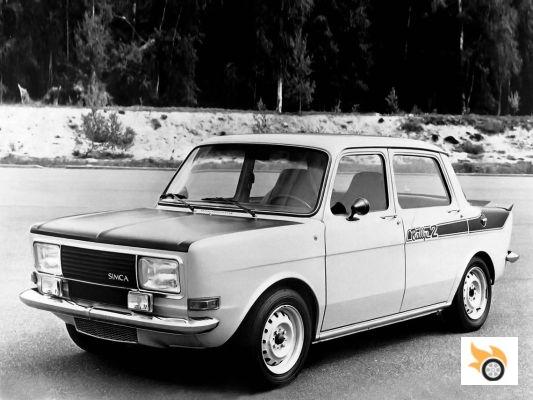The project to manufacture what we know today as Simca 1000 was born in the mid-fifties of the last century, when the French brand was the second French car manufacturer, just behind Renault, despite having such a limited range. But when the Sinai war broke out in 1956 (the Suez crisis from an "economic" point of view), it was the then owner of Simca, Henri Pigozzi, who contemplated the need to expand the range "down under", offering more economical vehicles, given the possibility that oil prices would increase and this would affect the sale of large and powerful vehicles.
Moreover, launching a new model was not a problem for a company in which Fiat and Ford had a shareholding and in which Chrysler was already beginning to show some interest. In fact, in 1958, Simca set up the subsidiary Simca do Brasil and acquired the Suresnes (Hauts-de-Seine, France) plant from Talbot. In 1959, Simca opened a factory in Casablanca (Morocco) and took over the Parisian companies Taxis G7 and Fonderies Modernes de l'Automobile.
The development of the Simca 1000
With the collaboration of the Italian Fiat and its experience in the manufacture of small and medium-sized cars, two similar projects were carried out with a four-door saloon, compact size, rear engine and an unladen weight of less than 750 kilos. These projects took the name 122 and 950, and their most striking difference was in terms of aesthetics: while the 122 project, led by the Italian Dante Giacosa, had a rounded silhouette reminiscent of the Fiat 1100, the 950 project led directly by Simca showed a squarer bodywork.
Between 1957 and 1960 numerous full-size models were made to determine the actual design of the car: the French created one that they modified little by little, while the Italians made up to four models. In any case, in the end the Simca project was chosen.
As for the mechanics, there were also discrepancies between the type of block, its position and the type of gearbox. In the end they opted for a vertical block and a four-speed gearbox, something that did not convince the Fiat group, which ended up abandoning the collaboration project and took advantage of the work done to launch the Fiat 850 in 1964. For its part, Simca went ahead with its 950 project but slightly tweaked it after getting some leaks on the Renault Super Dauphine project, which would lead in 1962 to the famous R8.
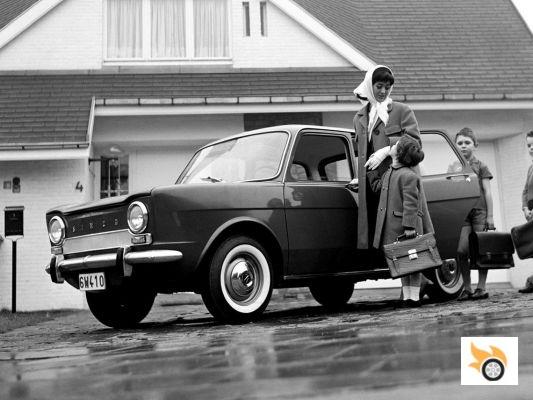
In the spring of 1960, the first road tests were carried out and a serious problem emerged: the lack of linear stability due to the unfavourable weight distribution between the axles. As strange as it may sound, to solve the dynamic problems of the Simca 950 project, the French manufacturer once again asked for the collaboration of his old Italian friends, especially the engineer Felice Mario Boano, responsible for the tuning of a large number of Ferraris of the time.
Another added problem was the discussions to choose the commercial name of the vehicle: some wanted to call it Arielle to give continuity to the old Simca Aronde and Ariane but others wanted a name that was indicative of something totally new, unrelated to the past and marked a turning point in the commercial policy of Simca. This is how it was decided that the new car would be called Simca 1000 and also how the numerical nomenclature of the brand began.
With all the work already done, production of the Simca Vedette was completed at the end of 1960 and the factory in Poissy (Saint-Germain-en-Laye, France) was adapted for the production of the new Simca 1000.
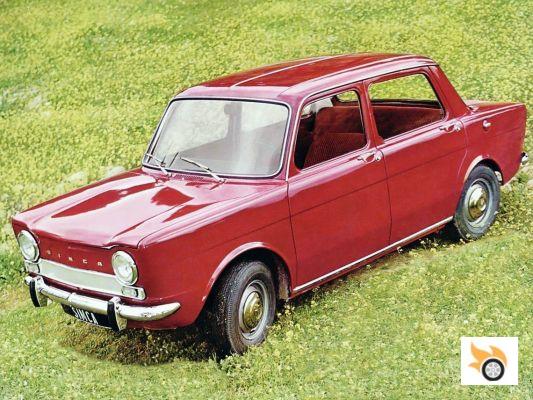
The first full production run
Although the Simca 1000 was presented to the press in late summer 1961 at the Monthlèry circuit (Ile-de-France), the official presentation to the general public took place on 10 October 1961 at the last Paris Motor Show to be held at the Grand Palais, as the 1962 show was held at the Parc des Expositions de la Porte de Versailles, in the 15th arrondissement of the French capital.
The launch of the Simca 1000 was attended by two important political figures of the day: French President Charles-André de Gaulle and the Shah of Iran Mohammad Reza Pahleví, making the Simca 1000 the undisputed king of the remembered and nostalgic 1961 Paris Motor Show. When the public was already able to see the new Simca 1000, the first thing that caught their attention was its interior, with clear reminiscences of Fiat. Not in vain, the design had been the responsibility of Mario Revelli di Beaumont, who despite being an independent designer, had participated in many projects with the Italian brand.
The dashboard of the Simca 1000 had a markedly horizontal development, with a speedometer suspiciously similar to those used by Fiat and, as a novelty, with a closed compartment in front of the passenger compartment as a glove box. As far as the exterior was concerned, however, there were not many surprises. The Simca 1000 presented a square and classic line but with a good aesthetic fit between the three volumes. At the front, the verticality of the front end stood out, presided over by two large round headlights and the false grille delimited by two small optical groups that served as position and indicator lights. The rear view was also very heavy to the eye with its square shapes and small circular optical groups.
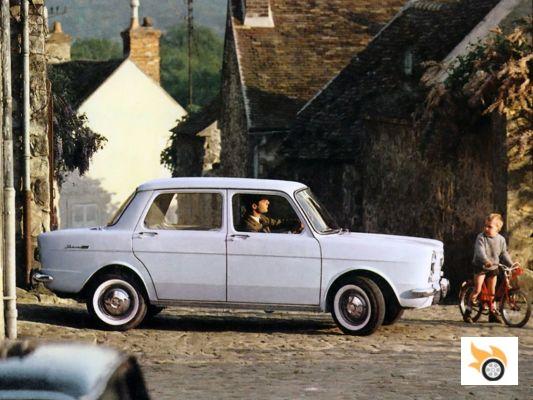
The side view, however, was lighter because it combined the rounded edges in the silhouette of the doors and windows with two tension lines completely straight and parallel to the ground, one at the height of the wheels and the other running the entire length of the car. In addition, in a three-quarter view, either front or rear, you could see how the Simca 1000 had a bulging beltline at the base of the side windows and a sort of groove or indentation running lengthwise along the roof.
The small size of the vehicle, especially the width of only 1.47 meters, made the cabin comfortable only for four passengers who would enjoy, yes, a relatively spacious cabin in relation to what the competition offered thanks to the use of the flat surfaces of the body, which gave an image perhaps a little elementary on the outside but take full advantage of the interior space.
A very criticized point of the Simca 1000 was its "trunk" located in the front part of the body thanks to the arrangement of the fuel tank between the rear seat and the engine (also rear). This "boot" not only had a capacity of only 180 litres, it was also totally irregular, which didn't make it very easy to use.

The Italian and the German side
Despite the constant disagreements between the Italian and French engineers, the Simca 1000 was full of technical solutions developed by Fiat. Rudolf Hruska, one of the key figures in the development of the Alfa Romeo of the time, also collaborated in the technical development. Many of the mechanical components of the Simca 1000 were taken without major modifications from the Fiat 600 parts bank, such as the engine and gearbox mounts, the independent suspension with oscillating arms, the four-wheel drum braking system and the worm gear steering.
All these parts were mounted on the Simca and there were only small variations to adapt them from one car to another. Others were slightly modified, such as the small hydraulic shock absorber in the steering system. The umpteenth argument among Simca engineers was over the introduction of a solid steel V-shaped rear support from the rear axle to the centre of the rear spar to support the engine block and improve torsional rigidity at the rear of the car, but which increased the weight on the rear axle and compromised the front axle's grip.
The first units put into circulation used a 944 cubic centimetre four-cylinder engine designed and built by Simca and which broke with the construction tradition of both Fiat and Simca itself. This block was located in the rear with a longitudinal arrangement but inclined 15 degrees to the left to save vertical space. This block did have a small concession to Fiat, and that was that the radiator was on one side of the block, as in the Fiat 600. This block offered a maximum power of 34 horsepower, enough to reach 125 km / h in the best case.
The Simca 1000 transmitted its power through a four-speed manual gearbox that was very advanced for the time, both in comparison with the gearboxes fitted to cars in its segment and those belonging to higher segments: it had four synchronised speeds and was made in collaboration with Porsche.
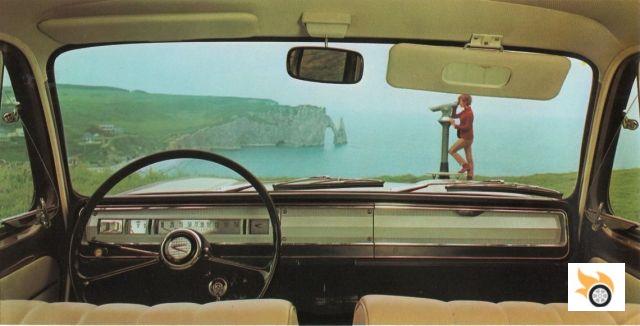
Commercial development
Initial production of the Simca 1000 was 250 units per day, a figure similar to that of any middle-class saloon of the time. It was a modest figure in relation to the initial forecasts because the public reception was not as expected due to the exaggerated interior austerity, a not very well calibrated steering and the behavior that the car had for its special architecture of "all back". Despite this, once the car began to be seen on the road, there was a kind of commercial pull and in the first year almost 110,000 units had already been manufactured thanks to the progressive increase in production to 800 units per day.
In 1963 some improvements were made to the Simca 1000 engine, which now offered 39 horsepower, and the range was completed with the arrival of two new models. On the one hand, the Simca 900 appeared with an even more austere presentation and lacked the rubber bumpers and chrome on the windows and headlights. On the other hand, the Simca 1000 GL was also presented with a more careful presentation, metallic paint, chrome side molding ... and with an eye on the imminent presentation of the Renault R8.
At this point I want to clarify that once this vehicle began to be manufactured in Spain, the Simca 900 used an 844 cc and 38 hp engine block. 1963 was a very important year for the Simca 900 / 1000 as it was the year in which the most units were produced: about 168,000. In 1964 the Simca 900 / 1000 received a series of improvements in response to criticism of its imprecise steering and poor interior finish. In addition, in collaboration with the Italian company Abarth, the Simca Abarth 1150 was launched, equipped with a 1,137 cc engine and available in four power levels: 55, 58, 65 and 85 hp, which allowed it to reach 170 km/h (105 mph).
In 1965, with the entry of Simca into Chrysler's orbit, the production of the Simca Abarth 1150 models came to an end, which is why today they are very rare units with a high economic value among collectors. It was also in 1965 that the model that "The Inhumans" would have liked so much was introduced: the Simca 1000 GLS with reclining seats and firmer upholstery among other details that placed it at the top of the range. In 1966 the first update took place; the first thing that caught the eye was the elimination of the Simca 900 from all markets except the Spanish one, where it remained until 1978 when the commercial life of this vehicle came to an end.
From this moment the range was structured around a single mechanical option of 39 hp and four levels of equipment: L, LS, GL and GLS. Common to all of them was a new dashboard equipped with a newly designed speedometer, a new rear seat with folding backrest to increase cargo space and the introduction of deflectors or wind deflectors on the front windows. The only mechanical innovation was the introduction of the three-speed semi-automatic gearbox of Verti origin, which gave rise to the GLA version, whose presentation and equipment was the same as that of the Simca 1000 GL.
The 1968 range included 774 combinations: five models, nine colours and 17 trims.
Despite these modifications, sales of the Simca 1000 went into a worrying decline: in 1967 they dropped below 100,000 units and in 1968 it was even worse. The real reason I don't know, but there are many voices that indicate that the main reason was that the Simca was seen as an "old" car compared to its main competitor: Renault 8 (it was called Renault R8 only until 1965). It was also criticized by questioning the reliability of its engines, which were also very expensive in relation to the performance of the car.
To reverse these low sales figures, in 1968 the Simca 1000 was equipped with a new engine that kept the 944 cc, but no longer belonged to the Series 315, but the more modern 349 family that had premiered in 1967 the Simca 1100 (Simca 1200 in Spain). This new engine added only one more horsepower to the car's power, but it was much more pleasant to drive and fuel consumption had been greatly reduced.
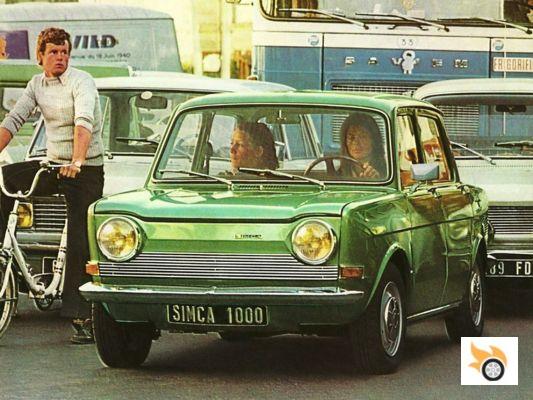
In 1969 finally came the much needed aesthetic update of the Simca 1000 that gave it the youthfulness that the original design denied it. The headlights, always round, increased in diameter, the false front grille was redesigned and the front indicators became rectangular and slightly invade the side wings. At the rear could be seen a new large square pilots.
At the chassis level the front was reinforced, the mechanical elements of the front axle were relocated (which allowed to increase the size of the trunk), the drop of the wheels was modified and a new rack and pinion steering was installed, which brought a significant improvement in what refers to the behavior of the car, which also helped the new team of 13-inch wheels. The engine was still the same as the previous year, but while the LS model retained 40 bhp, the GLS started to offer 42 bhp, and the L and GL models were no longer offered.
Only and exclusively for the French market, was developed the Simca Sim'4 version equipped with a 777 cc engine and 31 hp that received its name from the fact of having only four fiscal horsepower. Interestingly, this model kept the old 12-inch wheels.
A few months after this update, but already in 1970, appeared the Simca 1000 Spécial model that kept the high level of equipment of the Simca 1000 GLS but had a block of 1118 cc and 49 hp taken directly from the Simca 1100. With all these improvements had an impact on an increase in sales of the Simca 1000 that allowed throughout the year 1970 were produced about 108,000 units.
On 25 February 1970, the one millionth Simca 1000 left the Poissy factory and to celebrate this event, the performance of all the engines was improved. The Sim'4 version, exclusive to the French market, now offered 33 bhp, the LS and GLS versions both offered 44 bhp and the Spécial increased its power to 55 bhp, as well as starting to offer front disc brakes for the first time in the range.
With Chrysler's acquisition of Simca completed, the Simca 1000 Rallye version was launched at the end of 1970, equipped with the more powerful 55 bhp engine, the most austere trim level, the equivalent of the Sim'4, and a very sporty livery. This formula was a great success, especially among the younger generation, and was repeated years later by both Talbot and Peugeot.
All these continuous modifications meant that 1971 was also a good year for the Simca 1000, with almost 105,000 units sold.
Throughout 1972, production of the Renault 8 ceased (except in Spain) and this allowed the Simca 1000 to get rid of its closest competitor. Its substitute, the Renault 12, was already a much larger car than the Simca and aimed at a different public.
As far as the Simca 1000 was concerned, the only notable change was the introduction of a new 1,294 cc, 60 bhp engine for the Rallye and Spécial models and the GLS switched to the 1,118 cc, 55 bhp engine. This peace for the Simca 1000 was very short, very short. In fact, the 1973 oil crisis made fuel more expensive and sales of the youthful Rallye version were the first to suffer. Not so those of the Spécial, which despite having the same engine, was aimed at a different, more demanding market segment.
To better feel the oil crisis, Simca slightly adjusted its range to the new market demands. On the one hand ceased production of the Sim'4 model, appeared the GLE version, which was basically a GLS but with the 944 cc engine and Rallye versions ceased to be aimed at a young audience and focused on the absolute sportiness offered in various levels of power that reached 103 hp in its latest evolution. In 1975 small changes were introduced in the interior of the Simca 1000 with the adoption of a new instrument panel, new trim and new interior door panels.
The range was also updated with a new SR trim level available with both the 1,118 cc 55 bhp engine and the 1,294 cc 60 bhp engine, the GLS version reduced its range to just the 944 cc block and the Spécial to the 1,118 cc engine. Months later appeared the Simca 1000 Extra equipped with the 944 cc engine and had among its equipment with roll-up belts, tinted windows, carpeted floor and iodine headlights. Among its optional equipment was the sunroof or radio equipment.
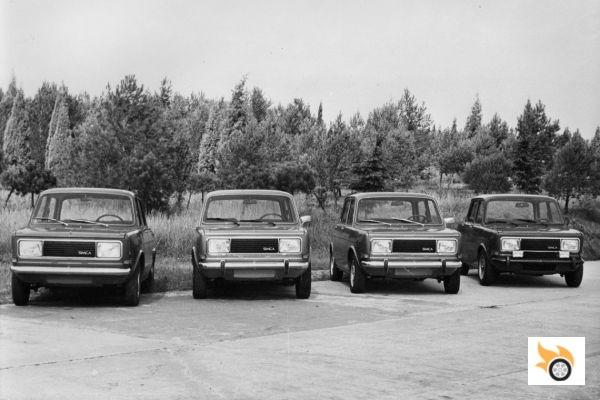
In 1976 came the update that would prepare the Simca 1000 for the end of its commercial life. The most notable is the introduction of rectangular headlights, the new location of the false front grille and the use of a new nomenclature for its name (again, except in Spain): Simca 1005 for models equipped with the 944 cc block (40 hp) and 1,006 for those equipped with the 1,118 cc block (55 hp). In any case, always with the GLS trim level. These models were accompanied by the Simca 1000 Rallye 3 equipped with the aforementioned 103 bhp engine capable of catapulting the Simca 1000 up to 180 km/h (180 mph).
In 1978, the Simca 1000 was replaced by the Talbot Horizon, initially available only in France, which was in fact the European version of the Dogde Omni.
